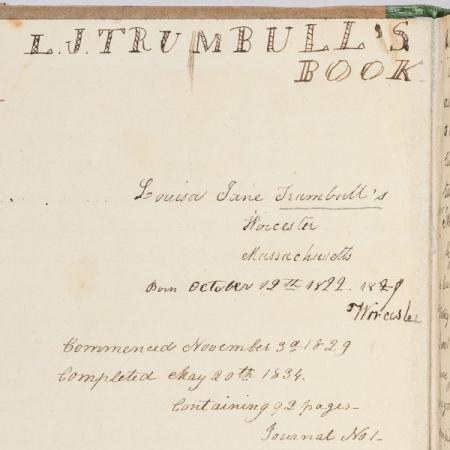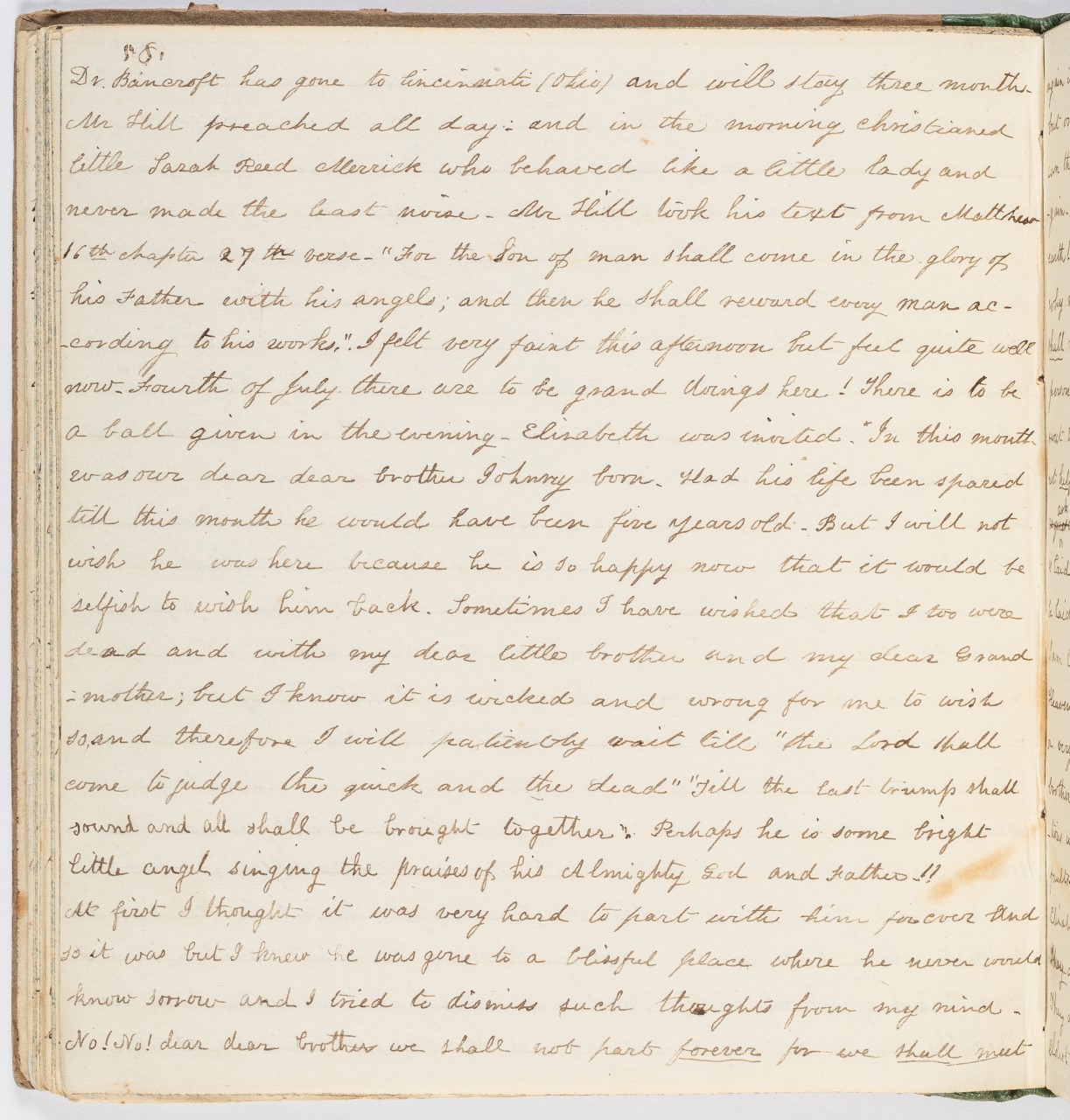
Inside the front cover of Louisa's diary (1829)
The youngest diarists in the Historic Voices of Children collection were only seven years old when they started keeping a diary. These two children, Louisa Jane “Jenny” Trumbull and Grenville Norcross, began their diaries in November 1829 and February 1861, respectively. The two children’s diaries give insight into what children learned in school, their perception of public holidays, their family relationships, and the ways they played and what they read. Both children were aware of the important occasion of beginning a diary by commenting on the process of diary keeping itself in their first entries. Jenny wrote on November 3, 1829: “As the other girls have got journals I thought that I would have one too, as Mother desired me to write what happens every day.”
Louisa Jane “Jenny” Trumbull (1822-1890) lived in downtown Worcester, Massachusetts, where her father owned a store on the city’s Main Street. Jenny did many things that seven-year-old children do today: she made and ate candy (“We made some molasses candy and it is very good” Dec. 5, 1829). She even complained about going to school, specifically about learning geography (“School will begin on Monday. Oh dear! What shall I do? I am sure I don’t want to go to school to learn Geography and History!” November 8, 1829).

But not everything in her life was fun and games. Jenny’s family had Irish maids working for them throughout Jenny’s childhood, and she sometimes commented negatively on the Irish people in her household. For instance, on December 25, 1833, she wrote, “Since I last wrote we have had a girl, an Irish girl, but she is very dirty and she quarrels with Nancy a great deal and Mother is not going to keep her.” She witnessed and commented on unhoused people in her hometown, writing on October 20, 1830, “We saw a poor old man laying on his pack on the grass asleep.” Jenny herself had a scar on her forehead from falling into a fire as a baby and witnessed her younger brother, John, die from scarlet fever in 1833 when she was just ten years old. Her entry from June 30, 1833, about his death is tragically sad: “Had his life been spared till this month he would have been five years old. But I will not wish he was here because he is so happy now that it would be selfish to wish him back. Sometimes I have wished that I, too, were dead and with my dear little brother and my dear grandmother; but I know it is wicked and wrong for me to wish so, and therefore I will patiently wait till ‘the Lord shall come to judge the quick and the dead.’ Jenny had 10 other siblings, but the death of her brother was a huge loss in her life.

Jenny’s diary is a small window into the life of a child in a city at the center of transportation in New England. On the Blackstone Canal and soon to be at the center of a network of railways, Worcester was on the cusp of industrialization in the 1820s and 1830s. Jenny’s diary tells of both the rewards and challenges of New England urban life from the perspective of one of the youngest children in this collection.
Suggested Classroom Questions and Activities
Ask your students to write the first few entries in a diary of their own and tell them to imagine that someone in the future will read their diary. How do they begin? What stories from yesterday or last week would they tell? Will they comment on the weather, what they did online, what they read in school, or what their friends said? Do they think anything interesting happened? Ask them to tell a story from last week with a beginning, a middle, and an end and also how they felt about it.
[Common Core State Standards Initiative (CCSS.ELA-LITERACY) W2.3 Write narratives in which they recount a well-elaborated event or short sequence of events, include details to describe actions, thoughts, and feelings, use temporal words to signal event order, and provide a sense of closure.]
To extend this activity, have students keep a daily or weekly diary and have them “publish” it by scanning it, printing out copies, and stapling it or stitching it together following a DIY bookbinding activity for kids.
[Common Core State Standards Initiative (CCSS.ELA-LITERACY) W2.6 With guidance and support from adults, use a variety of digital tools to produce and publish writing, including in collaboration with peers.]
To add on to this activity, have students incorporate quotations from their parents or teachers into their entries and then have them read aloud and record their entries, using different voices for their teachers, parents, and friends.
[Common Core State Standards Initiative (CCSS.ELA-LITERACY) SL2.5 Create audio recordings of stories or poems; add drawings or other visual displays to stories or recounts of experiences when appropriate to clarify ideas, thoughts, and feelings AND R2.6 Acknowledge differences in the points of view of characters, including by speaking in a different voice for each character when reading dialogue aloud]
Audio
Listen to Jenny's diary entries from November 3, November 8, December 5, 1829 and October 20, 1830. Jenny talks about going to school.